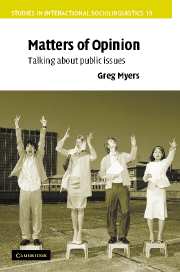Book contents
- Frontmatter
- Contents
- Acknowledgments
- Transcription conventions
- Focus-group data
- 1 Paradoxes of opinion
- 2 A tool kit for analysing group discussions
- 3 Forums for opinion: ‘What is it that's going on here?’
- 4 Institutions of opinion: voice of the people?
- 5 Topics in interaction: ‘Why that now?’
- 6 Agreeing and disagreeing: maintaining sociable argument
- 7 Representing speech: other voices, other places
- 8 Questioning expertise: Who says?
- 9 Radio phone-ins: mediated sociable argument
- 10 Vox pop television interviews: constructing the public
- 11 Opinions as talk
- References
- Index
4 - Institutions of opinion: voice of the people?
Published online by Cambridge University Press: 22 September 2009
- Frontmatter
- Contents
- Acknowledgments
- Transcription conventions
- Focus-group data
- 1 Paradoxes of opinion
- 2 A tool kit for analysing group discussions
- 3 Forums for opinion: ‘What is it that's going on here?’
- 4 Institutions of opinion: voice of the people?
- 5 Topics in interaction: ‘Why that now?’
- 6 Agreeing and disagreeing: maintaining sociable argument
- 7 Representing speech: other voices, other places
- 8 Questioning expertise: Who says?
- 9 Radio phone-ins: mediated sociable argument
- 10 Vox pop television interviews: constructing the public
- 11 Opinions as talk
- References
- Index
Summary
It is 15 September 2001. On the lower right-hand corner of the CNN home page is a frame labelled ‘Quick Vote’. It asks the question, ‘What are your feelings now about Tuesday's terrorist attack?’ There are three choices, each with a circle to tick:
Shock
Sorrow
Anger
At the bottom is a link to ‘Results’, which tells me that the current tally is 26 per cent shocked, 26 per cent sorrowful, and 49 per cent angry.
There are some obvious problems with this survey as an indication of public opinion. The sample is not representative: it includes only those with Internet access who are interested in the news and interested in giving their emotional response. The possible responses are limited to three nouns, the same three feelings set out in the same sequence as they were presented in the news reports (‘Americans are shocked and sorrowful today, but tomorrow they will be angry’). The ‘Quick Vote’ also assumes that participants interpret this question in the same way, no matter who asks or why, and it disregards their strength of feeling, or the differing reasons they might give for it. All the words have potentially variable meanings, and even the ‘now’ can slip; it does not correspond to the moment of clock time shown on my computer's browser but suggests to the respondent that now is different from then, that one will go through stages of feelings.
- Type
- Chapter
- Information
- Matters of OpinionTalking About Public Issues, pp. 67 - 88Publisher: Cambridge University PressPrint publication year: 2004

